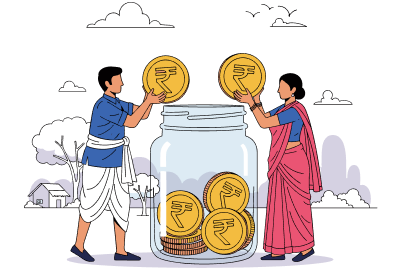- ++4.8 Rated

- 5.9 Crore Policies Sold
- 12.02 Crore Registered Consumer
- 51 Partners Insurance Partners
Protect your family today and get ₹1 Crore @478/month+

Tax benefit is subject to changes in tax laws







Here is the list of best life insurance companies sorted in order of highest to lowest Sum Assured(SA).
| Insurer Name | Investment Plans | 5 Year Returns | 10 Year Returns | |
| Private Insurer | ||||
| SBI Life Insurance Company | SBI Life-eWealth Plus | 15.7% | 12.3% | |
| HDFC Life Insurance | Click2Invest | 28.1% | 21% | |
| Axis Max Life Insurance | Online Savings Plan | 28.6% | 17.8% | |
| ICICI Prudential Life Insurance | EzyGrow - Wealth | 25.1% | 17.7% | |
| Tata AIA Life Insurance | Smart Fortune Plus-Wealth Secure | 27.3% | 17.9% | |
| Bajaj Life Insurance | Smart Wealth Goal V | 27.5% | 18.8% | |
| Birla Sun Life Insurance | Wealth Smart Plus | 22% | 15.4% | |
| Kotak Mahindra Life Insurance | E-Invest Plus | 20.7% | 14.2% | |
| PNB MetLife India Insurance | Smart Goal Ensuring Multiplier-Wealth | 20.3% | 15% | |
| Canara HSBC Life Insurance | Promise4Growth Plus - Wealth | 15.6% | 10.9% | |
| Star Union Dai-ichi Life Insurance | e-Wealth Royale | 14.2% | 10.2% | |
| Pramerica Life Insurance | Smart Invest 1 UP | 27.4% | 17.9% | |
| Bandhan Life Insurance | iInvest Advantage Plan | 20.1% | 13.8% | |
| Public Insurer | ||||
| Life Insurance Corporation of India | LIC India Index Plus | 13.3% | 14.9% |
Let us understand how life insurance works in the section below:



Life Insurance is broadly categorized into two types: Term and Investment. Let's explore the different types of life insurance plans as per your financial needs:

It is the simplest and most affordable type of life insurance policy
These plans offer financial protection (death benefit) for your family after your death
You have to pay fixed premiums for a chosen policy term

Under this type of policy, all your paid premiums are refunded upon survival till the policy term.
These plans offer both protection and a survival benefit
Life coverage provided by these plans is similar to that offered by basic term plans.

With ROP plans, you will get a full refund of the paid premium on early exit.
If you do not exit, the plan continues as a standard term policy
The plan allows the policyholder to tailor it to their specific needs.

Whole Life Insurance plans provide life cover till the age of 100
These plans ensure that your family gets lifelong financial protection
Such plans are Ideal for those who want to leave a lasting legacy

ULIP plans combine insurance and market-linked investments
In these plans, part of the premium goes to life cover, and the remaining is invested in funds
The amount you receive depends on market performance.

Dual Benefit of guaranteed returns with protection and savings
Offers a lump-sum payout on survival and death
Encourages disciplined savings

Designed for financial security after retirement
Regular income through an immediate or deferred annuity
Ensures steady cash flow in your post-retirement

Best for securing your child's education and life goals
Future premiums will be waived off if the parent passes away
Guarantees funds for the child's future needs

Offers both regular returns and life cover during the policy term
Benefits of life insurance and investment
Financial protection along with steady returns at fixed intervals

Corporate plans are designed for companies that want to manage benefits and safeguard their key people.
The plan is designed to cover executives or critical staff of the company
These type of plan provides the organisation with financial protection

These plans are specially designed for armed forces personnel and service members.
It is an affordable group life cover that comes with predefined benefits for families.
Such plans ensure financial security for the member's and their dependants dependents
As of 22 September 2025, the Goods and Services Tax (GST) on individual life insurance premiums in India is 0% (exempt). This change replaces the earlier 18% GST and makes life insurance significantly more affordable for individuals and families.
Current GST Rates on Life Insurance


Life Insurance policy protects your family’s financial future in your absence. If something unfortunate happens to you, your insurance company will provide a lump sum amount to your family. That payout is known as death benefit. In some life insurance policyes, the company also pays maturity benefit if the policyholder survives till the end of the policy term Not just this, having a Life Insurance also means that:
Your family is financially securer
Your outstanding debt will be taken care of
And, peace of mind
No, not ay all. This is a common notion amongst many people, but it is nit true. Life Insurance protects your family’s dreams, their happiness and their aspirations. The financial support it provides far outweighs the cost of premiums.
When you buy a life insurance, you have to fill in a form, where you need to disclose all your habits. In some cases, the company might ask for basic medical tests. These tests can possibly detect nictine and its by-products in your body. Therefore, disclosing all your lifestyle habits before buying life insurance is a must. If you hide anything now, it can cause several issues at the time of claims.
The main motive of buying life insurance is to get financial security. An individual buys a life insurance to ensure that even if he is not around in future, his family’s financial future should not get compromised.
To get an ideal life insurance coverage, always use a thumb rule of haing least 10-15 times your annual income as your coverage. Since you have 2 kids, their education, higher education, marriage and your retirement, it is ideal you choose a sum assured that will pay off your debts, maintain your family’s living standard, and is enough to cover their day to day expenses.
At Policybazaar, your feedback matters! We’re committed to providing you with the best experience possible. If our content is helpful to you, Please rate us!
By clicking on "View plans" you agree to our Privacy Policy and Terms of use
+Price is calculated for salaried, annual income 10 Lacs & education is graduate and above
Follow these simple steps to buy the best life insurance policy plans online from Policybazaar.

Buying life insurance is the first step toward securing your financial future. Here's what happens when you buy a life insurance policy
Government Yojanas offered by the Government of India are designed to provide affordable financial protection to individuals. Below are some of the schemes:
Submit the documents mentioned below to purchase a life insurance policy in India:
Any individual between the age group of 18 and 65. Any Indian Citizen or NRIs who can pay the premiums can buy life insurance policies.
First and the most important is that low premiums. Buying a life insurance policy in your early 20’s means that you will have to pay less premiums. You get the benefit of low premiums for the same coverage for which an older person will have to pay more.
Regular premium payments help build a savings habit early in your career, ensuring you set aside money systematically instead of spending it all.
In case if you have taken education loans, or have any credit card dues, with a life insurance policy, you can ensure that after you, these loans and debts don't burden your loved ones.
Even if you’re single, your parents or siblings might depend on your income. A life cover ensures they’re financially secure if something happens to you.
When young, your eyes is filled with dreams. To fulfil those you can invest ealy in ULIPs or endowment policies. These plans let you grow your savings and provide insurance protection side by side.
Premiums paid qualify for deductions under Section 80C, and the maturity or death benefits are tax-free under Section 10(10D), giving you both protection and tax relief.
An insurance policy benefits some other groups of individuals besides those discussed above.
There are several ways to evaluate the amount of life insurance one needs. Here is an easy-to-remember method called D.I.M.E. that everyone can use to check the life insurance amount.
Investing your money in different financial products expands your portfolio and helps you to save money. Taka look at the comparison of life insurance vs other savings products available in India:




Life Insurance is a safe investment option compared to other investment options, because of the below reasons:
Women should buy a life insurance plan ffor many reasons. Nowadays, a life insurance policy is not only just for men, it is important for both. No matter if you are a working woman, or housewife, the right life insurance cover is important. Here’s why every woman should consider investing in life insurance policy:
Here is a list of some factors that affect the life insurance plan's premium amount:
 Does Consuming Alcohol Affect Life Insurance Premiums?
Does Consuming Alcohol Affect Life Insurance Premiums?Your lifestyle choices can influence your premium — here’s how.
Yes, You can buy more than one life insurance policy. There's no legal or regulatory restriction on owning multiple life insurance policies in India. In fact, for many people, it makes sense to do so.
Having multiple life insurance plans helps you diversify coverage. One policy might offer life cover, another can help build wealth, and a third could support your goals like retirement or child planning.
While multiple plans offer better protection, they also mean higher premiums. If you're not careful, this can clash with other financial goals like saving for a house, a child's education, or retirement. In addition, more policies mean more renewal dates and documentation, and a greater risk of missing premium payments, leading to policy lapse.
Yes, Insurers will ask about your existing policies.Every time you apply for a new life insurance plan, insurers ask you to disclose details of your existing coverage. This helps them assess total insurability and avoid fraud. If you hide this information, it can cause claim rejections later.

Let us take a look at the following payout options available in life insurance:
You can follow these simple steps to file a claim:
You can claim your life insurance policy by either visiting the company's website or office and filling out the claim intimation form. If the policy is purchased via Policybazaar, you can contact your Relationship Manager, who will help you guide you through the claim process.
Here is a list of the documents required for life insurance claims
Attach the required documents to the claims form and submit in either online or at the nearest company office.
As per the IRDAI rules and regulations, the insurer must respond to the claim request within 30 days from the date of claim intimation. Most insurers have a proactive claim settlement duration, with some settling the claims within 4 hours of the request.
You can file both death and maturity claims through any of the following ways
Whether it's a death claim or a maturity claim, ensure you have all the required documents ready to speed up processing.
In the unfortunate event of a policyholder's death without a valid nominee, or if the nominee dies before the policyholder, the insurer can’t release the money to anyone immediately.
In this case, the decision will be taken as per the Indian Succession Act, the Hindu Succession Rules or the Muslim inheritance laws, the claim amount is divided among the legal heirs based on the rules of succession that apply to the person who owned the policy.
Yes, it does. The claim settlement gets delayed because the insurer requires proof of the legal heirs. The legal documents, such as a succession certificate or a legal heir certificate, are required, and obtaining them can take some time. Till then, the insurer keeps the amount aside, and interest is added as per IRDAI guidelines.
In this case, the payout is given to the legal heirs. Succession laws decide the legal heir. To ensure that the legal heir receives the payout, the insurer follows the above process.
Yes, they will. When you apply for a policy, the insurance companies will ask about your existing coverage. Doing this helps them to understand the coverage you already have and they can easily calculate your risk profile. If you hide your existing policy, you or your nominee might face problems at the time of claims.
As your life insurance policy matures, you will need to do the following steps to receive the maturity benefit:
Life Insurance offers comprehensive coverage. However, there are certain situations that are excluded. Below are the types of death that are not covered by most of the insurance companies.
In life, there are certain situations where you should update the terms and conditions of your life insurance policy. Here is a list of four times you should revisit your life insurance plan:
To answer what is term life insurance it is one of the simplest life insurance plans, which takes care of the expenses of your family in your absence in the form of a huge life cover for a very small premium. In case of the policyholder's untimely death, their family or nominee receives the Cover Amount as per the policy. These life insurance policy plans can be customized to one's needs by including add-on benefits like: Early Payout on Critical Illness, Additional payout on Accidental Death, Additional benefits on Diagnosis of Critical Illness, etc.
Anyone can buy 1 Crore term life insurance policy plan. If any of your family members is dependent on you for their expenses or future needs, then it is highly recommended that you get covered under term life insurance policy plans. Buying a Term life Insurance will ensure that your family is not impacted financially in your absence.
Yes, term insurance is a worthwhile purchase, especially if you want to ensure the financial protection of your loved ones in the event of your unfortunate demise. These plans provide the required financial security in your absence and help your family care for their needs.
Term insurance provides the required financial protection for your loved ones in the event of your unfortunate demise. The benefits of term life insurance plans are that they are highly affordable and offer long-term protection with a large life cover.
Your term insurance coverage amount should be a factor in your family's expenses, keeping inflation in mind.
A simple way to calculate is to go up to 25x your annual earnings to cover your family's financial needs in your absence sufficiently. A human life value calculator can check your family's suitable life insurance cover amount.
ULIP plans are one of India's safest investments with the highest returns. These plans allow you to grow your money in the long run while providing life protection through the insurance component.
A mutual fund takes money from a lot of people and puts it into stocks, bonds, or other securities. A professional fund manager is in charge of the fund and decides where to put the money. You don't buy individual stocks; instead, you put your money into a fund and share the profits or losses based on how well the investments do.
There are many ways to save on taxes in India, such as ELSS mutual funds, the Public Provident Fund (PPF), the National Pension System (NPS), tax-saving fixed deposits, and life insurance premiums. Depending on how much risk you're willing to take and how long you plan to save, these options can help you lower your taxable income and reach your long-term savings goals.
The 50–30–20 rule is an easy way to keep track of your monthly income. About half of it goes to important things like rent, food, and bills. Thirty percent is set aside for things like travel and fun that are part of your lifestyle. The other 20% is put away or invested for retirement, emergencies, or future goals.
The best investment to grow money depends on your individual needs. You may opt for a capital guarantee plan if you require a certain amount as a fixed life cover and your wealth creation. If you require an investment plan with higher returns and a flexible insurance component, you may opt for a ULIP plan.
It depends on the type of investment and the risk profile you have chosen. A monthly investment of Rs. 5000 can get different returns. Before investing, thoroughly research the types of plans and investment options available, and assess their potential returns.
The 4 major types of investment options available in India are as follows:
Before buying an investment plan or investing in a fund, do thorough research.look out for the following factors before investing in a market-linked or guaranteed return life insurance policy plan
A legal agreement between the insurance company and a policyholder. Under this contract, the policyholder promises to pay regular premiums against the financial protection of their family. Life insurance plan safeguards your family's future by paying a lump sum in case of an unforeseen event.
Life Insurance is a must for everyone. Any individual who has financial dependent should buy a life insurance. If you are a married man, parent of a children, business owner, housewife, working professional or anyone, if someone is financially dependant on you, Life Insurance ia must for you.
Life Insurance makes sure that your family’s finances are looked after in your absence. Term insurance covers your life, and endowment policies, ULIPs, and whole life insurance can help you save money over time while also protecting you. These plans can help you reach goals like saving for a child's education, planning for retirement, or making a habit of saving money, and they will still pay out to your family in case something bad happens.
A term insurance. It is the most affordable and purest form of life insurance. Premiums of term insurance are low. However, factors such as smoking, health conditions, high-risk occupations, and age can affect the premium amount.
Term Insurance
Whole Life Insurance
Universal Life Insurance
Unit Linked Insurance Plans (ULIPs)
Term Insurance is a pure form of insurance. In this you don’t get any maturity benefits. Only death benefit is paid upon the death of the policyholder.
On the other hand, life insurance combines life cover with savings or investment. It pays out in two ways: upon death (death benefit) and at the end of the policy term (maturity benefit), making it a valuable tool for long-term financial planning. However, it comes at a significantly higher premium than term insurance.
Yes, according to the 80C section of the Income Tax Act, policyholders can avail tax benefits with life insurance policies. The premiums paid for life insurance are tax-exempt up to a maximum limit of Rs 1.5 lakh.
In life insurance, the surrender value is the amount the insurance company pays if the policyholder terminates the plan before it matures. Suppose the policyholder chooses to surrender the policy mid-term. In that case, the insurance company will provide the portion of the sum that has accumulated from earnings and savings up to that point.
Yes, you can buy multiple life insurance policies. Buying multiple policies can provide broader coverage and act as a backup. However, before making a decision, always check your future financial goals, your and your family’s needs. Also, check if you will be able to manage multiple policies. Therefore, review everything thoroughly and then make a decision.
To raise awareness about insurance, the Life Insurance Council of India launched "Sabse Pehle Life Insurance," a mass media awareness campaign. The main objective of the campaign was to spread awareness and educate Indian households about the importance of life insurance.
Yes you can withdraw money from your life insurance policy. Some life insurance policies, such as savings plans or ULIP plans, allow the option of money withdrawal. Review the policy document to understand the terms and conditions.
Yes, in India, manny insurers have introduced mobile apps to simplify the insurance process for their customers.Through this app, policyholders can easily check their policy stays, pay premiums online etc. Few insurers who have their mobile apps are:
LIC Customer app by LIC of India
SBI YONO App by SBI life
HDFC Life Insurance App by HDFC Life
The 7 core principles of insurance that govern contracts and claims are:
Utmost Good Faith (honesty)
Insurable Interest (financial stake)
Indemnity (restoration to prior state)
Proximate Cause (direct cause of loss)
Subrogation (insurer steps into insured's shoes)
Contribution (sharing loss among insurers), and
Loss Minimization (duty to prevent further damage).

Insurance companies are now introducing women-only term insurance plans featuring benefits like premium holidays, childcare riders, and health perks. These life insurance plans target homemakers, who were often excluded earlier because they did not have steady income sources. Term insurance offers high life cover for a low price, but not many people buy it because they expect a payout at the end of the term. Eligibility usually requires regular income and good health. With these women-specific plans, insurers aim to make life cover more accessible, helping women secure their families’ financial future while enjoying tailored benefits for health, childcare, and lifestyle needs.
Term Insurance :˜The insurers/plans mentioned are arranged in order of highest to lowest Sum Assured(SA) offered by Policybazaar’s insurer partners offering term insurance plans on our platform, as per ‘first year premium of life insurers as at 31.03.2025 report’ published by IRDAI.Policybazaar does not endorse, rate or recommend any particular insurer or insurance product offered by any insurer. For complete list of insurers in India refer to the IRDAI website www.irdai.gov.in
Investment Plans :˜The insurers/plans mentioned are arranged in order of highest to lowest first year premium (sum of individual single premium and individual non-single premium) offered by Policybazaar’s insurer partners offering life insurance investment plans on our platform, as per ‘first year premium of life insurers as at 31.03.2025 report’ published by IRDAI. Policybazaar does not endorse, rate or recommend any particular insurer or insurance product offered by any insurer. For complete list of insurers in India refer to the IRDAI website www.irdai.gov.in
Rs. 400/month is starting price for a 1 crore term life insurance for an 18 year-old male, non-smoker, with no pre-existing diseases, cover upto 30 years of age, rounded off to nearest 10.
Rs. 400/month (Rs.13/day) is starting price for a 1 crore term life insurance for an 18 year-old male, non-smoker, with no pre-existing diseases, cover upto 30 years of age.
+Rs. 230 is starting price for a 50 lakhs term life insurance for an 18 year-old male, non-smoker, with no pre-existing diseases, cover upto 30 years of age, rounded off to nearest 10.
+Rs. 8/day is starting price for a 50 lakhs term life insurance for an 18 year-old male, non-smoker, with no pre-existing diseases, cover upto 30 years of age, rounded off to nearest 10.
+Rs. 12/day is starting price for a 75 lakhs term life insurance for an 18 year-old male, non-smoker, with no pre-existing diseases, cover upto 30 years of age, rounded off to nearest 10.
+Rs. 497/month is starting price for a 1.5 crore term life insurance for an 18 year-old male, non-smoker, with no pre-existing diseases, cover upto 30 years of age.
+Rs. 487/month is starting price for a 2 crore term life insurance for an 18 year-old male, non-smoker, with no pre-existing diseases, cover upto 30 years of age.
+Rs. 626/month is starting price for a 3 crore term life insurance for an 18 year-old male, non-smoker, with no pre-existing diseases, cover upto 30 years of age.
+Rs. 905/month is starting price for a 5 crore term life insurance for an 18 year-old male, non-smoker, with no pre-existing diseases, cover upto 30 years of age.
+Rs. 1,267/month is starting price for a 7 crore term life insurance for an 18 year-old male, non-smoker, with no pre-existing diseases, cover upto 30 years of age.
*The full refund of premium is available on availing the one-time option of refund of premium. Total premium paid for policy (paid for add-ons) will be the special exit value, payable on availing the one-time option of refund of premium if you wish to completely exit the policy.
+Rs. 447/month is starting price for a 1 crore term life insurance for an (NRI) 18 year-old male, non-smoker, with no pre-existing diseases, cover upto 30 years of age.
+Rs.679/month is starting price for a 2 crore term life insurance for an (NRI) 18 year-old male, non-smoker, with no pre-existing diseases, cover upto 30 years of age.
+Rs. 910/month is starting price for a 3 crore term life insurance for an (NRI) 18 year-old male, non-smoker, with no pre-existing diseases, cover upto 30 years of age.
+Rs. 1,374/month is starting price for a 5 crore term life insurance for an (NRI) 18 year-old male, non-smoker, with no pre-existing diseases, cover upto 30 years of age.
+Rs. 1,924month is starting price for a 7 crore term life insurance for an (NRI) 18 year-old male, non-smoker, with no pre-existing diseases, cover upto 30 years of age.
Women
+Rs. 400/month is Starting price for a 1 crore term life insurance for an 18 year-old Female, non-smoker, with no pre-existing diseases, cover upto 30 years of age, rounded off to nearest 10.
Rs. 461/month is the starting price for a 1 crore term life insurance for an 24 year-old female, non-smoker, with no pre-existing diseases, cover upto 54 years of age.
1,642/month is the starting price for a 1 crore term life insurance for an 44 year-old female, non-smoker, with no pre-existing diseases, cover upto 74 years of age.
Prices offered by the insurer are as per the IRDAI approved insurance plans | #All savings and online discounts are provided by insurers as per IRDAI approved insurance plans | Standard Terms and Conditions Apply | **Tax Benefits are subject to changes in tax laws.| Policybazaar Insurance Brokers Private Limited
We will respond in the first instance within 30 minutes of the customers contacting us. 30-minute claim support service is for the purpose of giving reasonable assistance to the policyholder in pursuance of the claim. Settlement of claim (including cashless claim) is the responsibility of the insurer as per policy terms and conditions. The 30-minute claim support is subject to our operations not being impacted by a system failure or force majeure event or for reasons beyond our control. For further details, 24x7 Claims Support Helpline can be reached out at 1800-258-5881
For more details on risk factors, terms and conditions, please read the sales brochure carefully before concluding a sale
